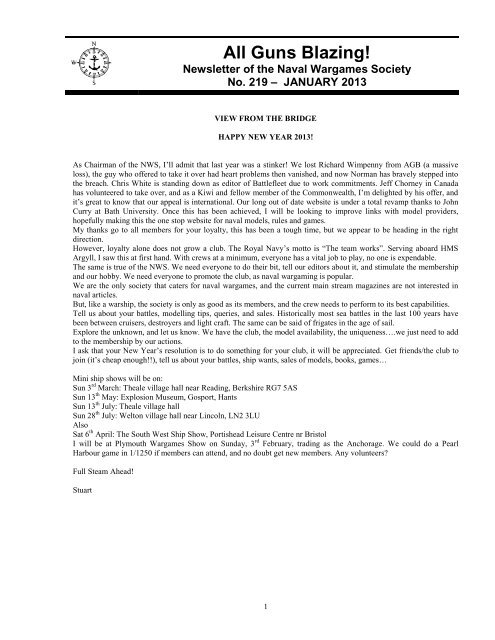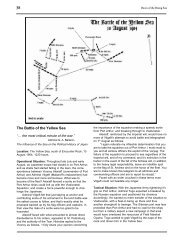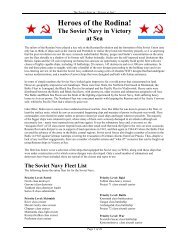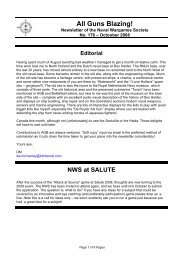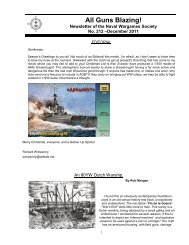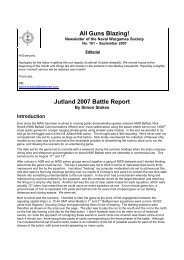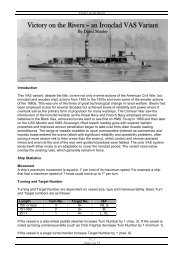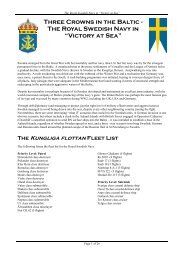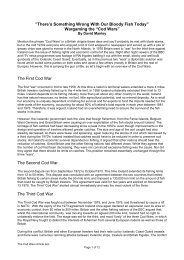All Guns Blazing! - The Naval Wargames Society
All Guns Blazing! - The Naval Wargames Society
All Guns Blazing! - The Naval Wargames Society
You also want an ePaper? Increase the reach of your titles
YUMPU automatically turns print PDFs into web optimized ePapers that Google loves.
<strong>All</strong> <strong>Guns</strong> <strong>Blazing</strong>!<br />
Newsletter of the <strong>Naval</strong> <strong>Wargames</strong> <strong>Society</strong><br />
No. 219 – JANUARY 2013<br />
VIEW FROM THE BRIDGE<br />
HAPPY NEW YEAR 2013!<br />
As Chairman of the NWS, I’ll admit that last year was a stinker! We lost Richard Wimpenny from AGB (a massive<br />
loss), the guy who offered to take it over had heart problems then vanished, and now Norman has bravely stepped into<br />
the breach. Chris White is standing down as editor of Battlefleet due to work commitments. Jeff Chorney in Canada<br />
has volunteered to take over, and as a Kiwi and fellow member of the Commonwealth, I’m delighted by his offer, and<br />
it’s great to know that our appeal is international. Our long out of date website is under a total revamp thanks to John<br />
Curry at Bath University. Once this has been achieved, I will be looking to improve links with model providers,<br />
hopefully making this the one stop website for naval models, rules and games.<br />
My thanks go to all members for your loyalty, this has been a tough time, but we appear to be heading in the right<br />
direction.<br />
However, loyalty alone does not grow a club. <strong>The</strong> Royal Navy’s motto is “<strong>The</strong> team works”. Serving aboard HMS<br />
Argyll, I saw this at first hand. With crews at a minimum, everyone has a vital job to play, no one is expendable.<br />
<strong>The</strong> same is true of the NWS. We need everyone to do their bit, tell our editors about it, and stimulate the membership<br />
and our hobby. We need everyone to promote the club, as naval wargaming is popular.<br />
We are the only society that caters for naval wargames, and the current main stream magazines are not interested in<br />
naval articles.<br />
But, like a warship, the society is only as good as its members, and the crew needs to perform to its best capabilities.<br />
Tell us about your battles, modelling tips, queries, and sales. Historically most sea battles in the last 100 years have<br />
been between cruisers, destroyers and light craft. <strong>The</strong> same can be said of frigates in the age of sail.<br />
Explore the unknown, and let us know. We have the club, the model availability, the uniqueness….we just need to add<br />
to the membership by our actions.<br />
I ask that your New Year’s resolution is to do something for your club, it will be appreciated. Get friends/the club to<br />
join (it’s cheap enough!!), tell us about your battles, ship wants, sales of models, books, games…<br />
Mini ship shows will be on:<br />
Sun 3 rd March: <strong>The</strong>ale village hall near Reading, Berkshire RG7 5AS<br />
Sun 13 th May: Explosion Museum, Gosport, Hants<br />
Sun 13 th July: <strong>The</strong>ale village hall<br />
Sun 28 th July: Welton village hall near Lincoln, LN2 3LU<br />
Also<br />
Sat 6 th April: <strong>The</strong> South West Ship Show, Portishead Leisure Centre nr Bristol<br />
I will be at Plymouth <strong>Wargames</strong> Show on Sunday, 3 rd February, trading as the Anchorage. We could do a Pearl<br />
Harbour game in 1/1250 if members can attend, and no doubt get new members. Any volunteers?<br />
Full Steam Ahead!<br />
Stuart<br />
1
<strong>The</strong> Prime Minister has welcomed Sir John Holmes' review into the rules and principles governing the award of<br />
military campaign medals.<br />
As part of his review, which was requested by Mr Cameron, Sir John Holmes has recommended new medals for veterans of<br />
the Arctic Convoys and Bomber Command Second World War campaigns. <strong>The</strong> Prime Minister has agreed that there is a case<br />
for the new medals. Veterans of the Arctic Convoy campaigns will get recognition with an Arctic Convoy Star medal.<br />
Meanwhile, the aircrew of Bomber Command who played such a vital role in the war will be awarded a Bomber Command<br />
clasp.<br />
View from the cruiser HMS Sheffield during an Arctic Convoy escort patrol, December 1941 (library image) [Picture:<br />
Lieutenant R G G Coote, Royal Navy. © IWM (A 6892)]<br />
An underwater detonation erupts next to HMS Ashanti during a convoy to Russia in September 1942. <strong>The</strong> destroyer HMS<br />
Eskimo is seen in the foreground. Merchant ships are in the background (library image) [Picture: British Newsreel Pictures. ©<br />
IWM (A 12022)]<br />
Arctic Convoy heroes to finally receive medal, 70 years after risking their lives to keep supplies open in a frozen<br />
hell<br />
Britain is finally to award medals to Second World War veterans of the Arctic Convoy missions. <strong>The</strong> government had<br />
previously refused to provide recognition of the sailors' bravery in keeping supply lines open to the Eastern Front,<br />
because the conflict was too long ago.<br />
2
Frozen hell: Sailors chipping away the ice and snow from the deck of H.M.S. Vansittart while on convoy escort duty<br />
in the Arctic in February 1943<br />
Appalling cold: Snow and ice covered the upper works of all ships<br />
More than 66,000 British sailors and merchant seamen braved sub-zero temperatures and ran the gauntlet of German<br />
warplanes and U-boats to keep the Soviet Union supplied on the Eastern Front. Winston Churchill once described<br />
them as having made 'the worst journey in the world'.<br />
Only around 200 veterans are still alive today - a fifth of the number a decade ago. Many wanted a medal as their<br />
'dying wish'.<br />
Hero: In perilous conditions a sailor frees chains, wires and bollards from the ice<br />
3
Unsung: One of 78 convoys that braved frozen seas to help win the war<br />
Those who took part in the British Arctic convoy ran a gauntlet of U-boats and vicious weather conditions to bolster<br />
efforts on the Eastern Front<br />
A total of 78 convoys delivered four million tons of vital cargo and munitions to the Soviet Union – allowing the Red<br />
Army to repel the Nazi invasion. <strong>The</strong> cost in lives was horrific. More than 3,000 UK seamen were killed in the<br />
treacherous waters of the Arctic Ocean as they undertook the terrifying trips to keep Russia supplied and fighting on<br />
the Eastern Front. In total, 85 merchant and 16 Royal Navy vessels perished between 1941 and 1945. Over four years,<br />
the convoys delivered 7,000 warplanes, 5,000 tanks and other battlefield vehicles, ammunition, fuel, food, medicine<br />
and further emergency supplies. Because Norway and the Baltic states had been captured by Germany, the only way to<br />
get the goods to Russia was through the northern ports of Murmansk and Archangel, both inside the Arctic Circle.<br />
A French Fleet in Mexico.c1840.<br />
A Note by Rob Morgan.<br />
One of my colleagues based in Normandy has sent me a copy of a French Navy Ship List dating from 1838 which in<br />
part answers some questions I had about that short but interesting naval war between Mexico and the Republic of<br />
Texas. I’ll return to that conflict later, but this gives a list of what must have been the most powerful Squadron active<br />
anywhere in the Americas at that time. French troops had of course landed at Veracruz in 1838, and the US Navy did<br />
not interfere, in this post-Monroe Doctrine era. Even though six Mexican Brigs based at Veracruz had been deployed<br />
against the fledgling, vigorous Texan force of schooners, brigs and privateers. An interesting small naval campaign in<br />
itself.<br />
<strong>The</strong>se six brigs were immediately seized by the French, and though the following list doesn’t indicate that any of the<br />
seven Brigs listed were the Mexican warships, it would be remarkable if the original expedition consisted of such a<br />
high proportion of Brigs compared to other vessels.<br />
<strong>The</strong> French fleet in Mexico was commanded by Vice-Admiral Baudin, who flew his flag in the Frigate Neriede (52).<br />
Five frigates in all constituted the strength of the fleet, with a single Corvette, 7 Brigs, 4 bomb vessels, 2 auxiliaries, an<br />
4
armed transport and 3 armed steamers. A substantial force. <strong>The</strong> Frigates were Nereide (52), Iphegenie (60), Herminie<br />
(60) Gloire (52) and Medee (46). <strong>The</strong> Corvette Creole (24) was commanded by the Prince de Joinville. <strong>The</strong> Brigs were<br />
a mixed bunch, which perhaps indicates that some were Mexican captures re-named. Alcibiade (20), Voltigeur (20),<br />
Cuirassier (18), and the smaller Eclipse (10), Dupetit-Thouars (10), Laurier (10) and Zebre (10). <strong>The</strong> four bomb<br />
vessels were Cyclope, Volcan, Éclair and Vulcain. <strong>The</strong> auxiliaries Caravane and Fortune, have no armament listed,<br />
nor has the transport Saumon. <strong>The</strong> three armed steamers were Veloce described as on a temporary mission to Mexico,<br />
and paddlers Phaeton and Meteore.<br />
<strong>The</strong> list gives the date of service in Mexican waters, all from 1838 and the landings at Veracruz, but there are a few<br />
exceptions. <strong>The</strong> Frigate Herminie was present in June 1835, while the 20 gun Brig Alcibiade was there in January<br />
1837, and so were the three small Brigs Eclipse, Dupetit-Thouars, and Laurier. <strong>The</strong> steamer Meteore is also listed as<br />
present off Mexico in late 1835.<br />
<strong>All</strong> of these warships can be found as very reasonably priced attractive models in the ‘Tumbling Dice’ 1/2400 th range.<br />
ASN 6 and ASN 7 will provide the 60 and 52 gun Frigates, ASN 12 the Corvette, ASN 16 the bombs, and ASN 13, 21<br />
and 22 the Brigs. For the few ‘gaps’, especially the transport Saumon, I turned to the Magister Militum list, which has<br />
the ‘Figurehead’ range in 1/2400 th , and these are very compatible with ‘Tumbling Dice’. From this I used FM-1 large<br />
merchantman from the Napoleonic series and for the steamers the same source, Fe-28 Screw/sail steamer for Veloce,<br />
and FE-27 for the two paddlers. <strong>The</strong> same ‘Tumbling Dice’ range will provide a small Texan naval force for<br />
commerce raiding, and for the ‘commerce’ ‘Figurehead’s’ FM-3, coastal craft.<br />
French reinforcements in the South Atlantic, as listed, if needed, would be the Frigate Minerve (58) at Brazil, under<br />
Rear-Admiral Leblanc, with the Frigate Junon (46) and the Corvettes Sappho (32), Camille (20) and Perle (18).<br />
Leblanc also had the Brigs Alerte (20), Adonis (20) along with D’Assas (20), and Badine, Sylphe and Lutin (10 guns<br />
each). This sizeable second French force also had the auxiliary Bonite, transports Indienne and Expeditive but no<br />
steamships.<br />
In the Caribbean, the French navy maintained the Frigate Astrees (46) in the Antilles, under the command of Rear<br />
Admiral de Moges, who also had with him the Corvette Thisbe (32), Brigs Bisson, Oreste, Cygne ( 20 guns each) and<br />
Inconstant (16), and Fabert (10). Also in the Antilles were the 800 ton auxiliaries Adour, Oise, and Aube, the small<br />
transports Lionne and Recherche. At Haiti the 24 gun Corvette Naiade, and Brig Griffon (20), and at Guadeloupe the<br />
small gunboat Alsacienne (4) completed a rather substantial French presence in American waters. Over fifty warships<br />
and auxiliaries not to mention three Admirals, in a small corner of the world, in the latter months of 1838. <strong>The</strong>re’s the<br />
recipe for more than one wargames campaign in there mes amis.<br />
Rob Morgan.<br />
<strong>The</strong> Making of the Bulgarian Navy.<br />
Few, I suspect, of the readers of this splendid newsletter, are familiar with the maritime monthly ‘SEA BREEZES’<br />
which graces the shelves at Smiths and other good newsagents. Even this enthusiast, dedicated to war at sea, barely<br />
glances at its contents as I pass by.<br />
<strong>The</strong> June 2009 issue however, contained a rare delight, a four page illustrated article on the subject of the creation and<br />
development of Bulgaria’s fleet during the ‘Liberation War’ against the Ottoman Turks in 1877-1878. <strong>The</strong> article, by<br />
Kaloyan Pancheliev, is entitled ‘<strong>The</strong> SS.OPYT’ after the first paddle-steamer warship donated to the new state of<br />
Bulgaria by Russia in 1879. As an account of the development of a small European fleet it’s interesting, touching<br />
briefly on the events of the 1877-78 War, on the important yet brief Serbo-Bulgarian War of two weeks in 1885, and<br />
the tense relations with her bigger neighbours until the outbreak of the Balkan Wars. <strong>All</strong> viewed through the<br />
perspective of a small man of war, later a Royal Yacht which would be little thought of in most European navies of the<br />
time.<br />
If you can find a copy, say through the British Library document access scheme at the local library, it’s very well<br />
worth a little time reading. Pancheliev certainly provides information on the value of river and coastal communications<br />
in war. It also informed me of that in October 1877, ‘Opyt’ took part in what must surely have been the last ever attack<br />
by fire-ships in history, during a raid by the Russian flotilla against the Ottoman ships in the port of Silistra. Now<br />
there’s a 19 th century naval wargame for you! Incidentally, if you want a model of the ship, then in the Navwar<br />
1/1200 th scale series, ACW64 ‘Mars’ a British built paddle steamer blockade runner looks almost identical to ‘Opyt’.<br />
Rob Morgan.<br />
5
<strong>The</strong> third instalment: KAISER’S KORSAIRS<br />
MOVE 8:<br />
<strong>The</strong> Melbourne Times reports:<br />
Patey Pastes Von Paigntonburg<br />
Epic sea battle off Rabaul, Royal Australian Navy's First Victory!<br />
<strong>The</strong> London Evening Standard reports:<br />
<strong>The</strong> Royal Navy's Reply, Revenge off Rabaul.<br />
In line abreast, with only masts in sight, the Australian fleet in the Solomon’s tracked the<br />
route of the enemy squadron. Warrego was the first to site them, steaming at just 9 knots,<br />
Prinz Eitel Friedrich to the rear of a 5 ship line. Hasty signals were exchanged, and Warrego<br />
lead her sister destroyers into the front of the enemy line. Keeping outside of enemy range,<br />
they waited until Australia fired her salvos to announce the battle. <strong>The</strong> initial salvos landed<br />
squarely on the rear ship, Prinz Eitel Friedrich. Ablaze from bow to stern, she settled and sank<br />
to starboard. Upon seeing this, the enemy squadron broke ranks. Kaiserin Elisabeth increased<br />
speed straight ahead. Emden turned away to starboard, together with Geier, both increasing<br />
speed. Titania turned fully away. Ignoring Titania, Australia's next salvos were aimed at the<br />
large gunboat Geier. <strong>The</strong> gunboat disappeared under the splashes.....and when the water<br />
subsided it revealed a shattered white hulk, settling bow first. In order to get across the bow<br />
of Kaiserin Elisabeth, the Australian destroyers raced ahead, closing the range. A fierce<br />
firefight ensued, with Parramatta on numerous times appearing to have been sunk, only to<br />
emerge unscathed. Following Australia was the cruiser Melbourne, who now turned to chase<br />
Titania. Australia turned her guns on the next in line, Emden. It was clear from her firepower<br />
and condition that she was in need of repair. An accurate 12" salvo made that repair<br />
impossible. Emden sank stern first, her stern severed. Ignoring the on rushing battlecruiser,<br />
the armour being too strong, von Paigntonburg concentrated on the nearest adversary,<br />
Parramatta. Her luck finally ran out, Parramatta sank quickly bow first. Retribution was swift.<br />
Australia’s first salvo landed squarely amidships the Kaiserin Elisabeth. She seemed to lift out<br />
the water as if by a giant hand, then break in two and sink within a minute. Melbourne's<br />
salvos proved equally accurate, as her bow 6" tore into the fleeing Titania. <strong>The</strong> German<br />
captain ordered his ship to stop, scuttling charges were exploded, and she settled beneath the<br />
waves. Intelligence gathered from enemy survivors. Nothing on Von Spee. Kaiserin Elisabeth<br />
sank 8 ships: Cruisers Dartmouth, Psyche and Pyramus, destroyers Itchen, Kennet and<br />
Parramatta, steamer Gaynor off Dutch East Indies and sailing ship Irish Lady off the Gulf of<br />
Thailand. Von Paigntonburg went down with his ship. Emden sank 3 ships: the cruiser<br />
Philomel, steamer Horsfield in the Gulf of Thailand and sailing ship Pakeha in the Dutch East<br />
Indies. Badly fire damaged from the Carolines Battle at time of sinking. Geier sank the sailing<br />
ship Penang in the Gulf of Thailand. Prinz Eitel Friedrich sank the steamers Fair Isle and Patia<br />
in the Gulf of Thailand and Dutch East Indies.<br />
<strong>The</strong> landings at Tanga in the MC have not been successful, although the sea blockade appears<br />
effective.<br />
<strong>The</strong> Cameroons convoy is now under escort of Madeira based cruisers, to be relieved by<br />
Admiral Cradock upon arrival in the Narrows (move 9).<br />
Concern is growing over Von Spee's whereabouts. <strong>The</strong> Admiralty considers the Pacific coast of<br />
South America to be most likely as it is unprotected. Dresden is known to be operating in<br />
these sea lanes, possibly with Leipzig. In the Atlantic both Karlsruhe and Kronprinz Wilhelm<br />
are known to be at large. Strasburg may also be active. Konigsberg is last believed to have<br />
6
een seen in the Cocos Islands, Indian Ocean.<br />
Well done chaps! And a medal Admiral Patey!<br />
Move 8<br />
Battle of Rabaul<br />
Kaiserin Elisabeth, leading Emden, Geier, Titania and Prinz Eitel Friedrich are spotted by the Australian destroyer<br />
Warrego heading west towards the German base at Rabaul, Solomon Islands. She is rapidly joined by her sister ships<br />
Yarra and Parramatta, which sensibly keep out of range. Tied to Titania’s slow speed of 9 knots, the squadron<br />
proceeds west, until the fighting tops of a battlecruiser are sighted by Prinz Eitel Friedrich. <strong>The</strong> initial 12” salvoes are<br />
deadly accurate. Prinz Eitel Friedrich is engulfed in flames and sinks rapidly to starboard. <strong>The</strong> Kaiserin Elisabeth<br />
orders all ships to disperse and escape, whilst increasing speed and heading straight on herself. <strong>The</strong> battlecruiser<br />
Australia now concentrates on Geier. A punishing salvo leaves her totally wrecked and she serenely slips beneath the<br />
waves. Kaiserin Elisabeth is now engaging the Australian destroyers who are heading her off with their superior<br />
speed. Emden is fleeing to starboard. To no avail. Another crunching salvo takes her stern away, and she sinks stern<br />
first beneath the waves. Titania is also fleeing West, with Melbourne in hot pursuit, salvos crashing into her.<br />
Kaiserin Elisabeth, knowing the end is near, concentrates on her inferior opponents. <strong>The</strong> destroyer Parramatta,<br />
having lived a charmed life, is obliterated by another accurate Austrian salvo. <strong>The</strong> celebrations are short lived.<br />
Warrego and Yarra pull away, allowing Australia to close. Under a deluge of 12” shells, Kaiserin Elisabeth breaks in<br />
2 and sinks rapidly, taking her legendary captain with her.<br />
<strong>The</strong> captain of the Titania acknowledges the futility of escape, stops engines, places scuttling charges and abandons<br />
ship. Melbourne picks up survivors.<br />
In German East Africa, the <strong>All</strong>ies invade at Tanga and invest Dar es Salaam. German forces cause a defeat, but are<br />
still forced to retire into the hinterland.<br />
Leipzig sinks the steamer SS Renfrew (2100 ton) and sailing ship Mercedes (600 ton) off Tehuantepec.<br />
Karlsruhe sinks the sailing ship Mary Clarke (700 tons) off the Windward Islands.<br />
Kronprinz Wilhelm sinks the steamer SS Vickery (1600 ton) off Jamaica.<br />
No sightings for the other ships.<br />
Tsingtao is still blockaded but in German hands. In Rabaul, the German colonists begin to accept the hopelessness of<br />
their situation.<br />
Move 9<br />
<strong>The</strong> Times reports:<br />
Von Spee’s Revenge! Sydney harbour attacked<br />
<strong>The</strong> German Asiatic Fleet raids Sydney. At night, using the unsuspecting merchant ship<br />
Flimwell as distant guide, the blacked out light cruiser Nurnberg raced into the harbour<br />
approaches. Spotting her bow wave, the guard ship monitor Cerberus signalled her to slow<br />
down and identify, turning on her searchlights. A hail of 4.1” was the reply, doing little<br />
damage to the heavily armoured monitor. Searchlights from Forts North Head and South<br />
Head swept the remaining harbour entrance as a fierce gun dual ensued. Suddenly Cerberus,<br />
under the glare of Nurnberg’s searchlights was deluged in large shell splashes, Scharnhorst<br />
and Gneisenau opening up from the blackened sea. Gallantly, Cerberus went down under this<br />
barrage. <strong>The</strong> Shore batteries now turned their attention on the armoured cruisers muzzle<br />
flashes, whilst Nurnberg closed Flimwell, ordering her to proceed at maximum speed. <strong>The</strong><br />
gallant merchant ship’s captain refused, and attempted to ram. Avoiding this with ease the<br />
Nurnberg raced on without the minefield being activated due to the close proximity of<br />
Flimwell and a lack of orders. Flimwell went on to beach herself on North Head.<br />
7
<strong>The</strong> colonial cruiser Protector, moored off the entrance to Port Jackson now took the Nurnberg<br />
by surprise. <strong>The</strong> response was swift, a torpedo from Nurnberg swiftly sending Protector to the<br />
bottom. <strong>The</strong> cruiser now swept north into the Middle Harbour, being hotly engaged by Fort<br />
Middle Head. Undeterred, Nurnberg wrought havoc with the anchored merchant ships, sinking<br />
4 and damaging 2. Meanwhile Scharnhorst and Gneisenau withdrew out of range of the outer<br />
forts guns, and blasted the 4” batteries on South Head into submission. Nurnberg now<br />
retired, Fort Middle Heads 4” batteries causing a brief fire on board, before steaming past the<br />
silenced South Head batteries. Without the aid of the destroyed searchlights, the mine field<br />
was activated visually on her bow wave, the decision to set it off en masse being deferred due<br />
to the presence of the armoured cruisers, who were now engaging Fort North Heads 9.2”<br />
batteries at distance, silencing a gun. Leaving huge explosions in her wake, she met up with<br />
the armoured cruisers then headed off into the twilight…..<br />
Panic is now reigning in the ports of Australia and New Zealand. First they read of the High<br />
Seas Fleets attacks on Scarborough, now this!<br />
In the Cocos Islands, HMS Clio’s shore party discovers the remains of a concealed coal dump,<br />
and attempt to repair radio station. Whilst duly engaged, the light cruiser Konigsberg<br />
surprises the anchored sloop. <strong>The</strong>re has been no further transmission from Clio, which is<br />
assumed sunk.<br />
<strong>The</strong>re are no other reports of enemy sightings, Admiral Craddock now having been joined by<br />
the Cameroon invasion convoy in the Narrows.<br />
<strong>The</strong> French gunboat Zelee confirms no sightings of enemy ships off Tahiti.<br />
Coaling status: several ships are getting low and players will have to plan ahead.<br />
Move 9<br />
Raid on Sydney<br />
Von Spee orders a raid on Sydney harbour. His captains meet to discuss how this can be achieved. <strong>The</strong> dangerous<br />
battlecruiser Australia is now known to be operating in the Solomon’s, which leaves negotiating the harbour defences.<br />
<strong>The</strong> entrance to the harbour is protected by Fort North Head (9.2”) and Fort South Head (4”), with a controlled<br />
minefield the whole width of the entrance. Once in, Fort Middle Head (4”) awaits, with other forts guarding the<br />
entrance to Port Jackson to the South, but none protecting the Middle Harbour to the North. Clearly, a daylight attack<br />
is out of the question. Also night is short in November, and the Australians are known to have submarines and coastal<br />
torpedo boats.<br />
It is agreed that Nurnberg will attempt to force the entrance at speed (good charts are available) whilst the armoured<br />
cruisers engage the two entrance forts. Once in, Nurnberg will attack shipping in Middle Harbour, before attempting<br />
an escape. Supremely risky, but a massive morale blow to the <strong>All</strong>ies, with small loss to the Axis.<br />
<strong>The</strong> support ships were to stay a further mile offshore, taking no part in the action.<br />
Midnight. As luck would have it, a merchant ship was sighted entering the Harbour. Recognition signals were flashed<br />
and a searchlight from the guardship HMAS Cerberus (monitor) illuminated the visitor. Taking advantage of this, the<br />
German squadron raced towards the entrance, Nurnberg leading with Gneisenau astern to port, Scharnhorst astern to<br />
starboard, all lights extinguished.<br />
Sighting the Nurnberg’s bow wave, Cerberus ordered her to identify and slow down. <strong>The</strong> reply was a hail of 4.1” and<br />
the blinding glare of the light cruisers searchlights. A fierce fire fight ensued, with little damage being done against<br />
the monitor’s armour, Nurnberg’s starboard torpedo tube being smashed. Both Forts now opened up and turned on<br />
their searchlights.<br />
This was the cue for the armoured cruisers to open up from the darkness, an accurate salvo from Scharnhorst sending<br />
Cerberus to the bottom, extinguishing her searchlights. Guided by the muzzle flashes, the forts now turned their<br />
attention on the armoured cruisers, allowing Nurnberg to close with the merchantman Flimwell. Holding fire,<br />
Nurnberg’s captain ordered Flimwell to increase speed. <strong>The</strong> response was a gallant attempt to ram, easily avoided by<br />
the agile light cruiser. But the result was perfect; no mines were exploded for fear of sinking Flimwell.<br />
8
<strong>The</strong> armoured cruisers now concentrated their fire power against Fort South Head, knocking out the 4” batteries and<br />
searchlights, staying out of range of Fort North Head.<br />
Nurnberg was in, only to be challenged by the anchored colonial cruiser Protector to port and Fort Middle Head to<br />
fore. Again searchlights lit up the scene. A torpedo from Nurnberg’s port tube slammed into Protector, sending her to<br />
the bottom. A good call, for minutes later a shell from Fort Middle Head smashed into the torpedo room.<br />
Rounding the headland, Nurnberg now blazed away with all guns at the anchored merchantmen, sinking the steamers<br />
SS Wodonga (2341 ton), Tokomaru (2800 ton), Te Anau (1652 ton), and Awahou (400 ton), damaging at least 2<br />
others. A request by the gunnery officer to send a few rounds in the direction of the cricket ground was refused;<br />
Kapitan von Fremburg pointing out that this is a place of English sporting disaster!<br />
<strong>The</strong> night being short, Nurnberg now departed the scene of destruction, only to be re engaged by Fort Middle Head. A<br />
potentially disastrous fire started amidships, but the gallant crew manfully smothered the flames. Staying as close as<br />
the charts permitted to the South Head, Nurnberg increased speed and raced past the silent Fort, onto the minefield.<br />
<strong>The</strong> steamer Flimwell could be vaguely discerned beached on North Head and the Forts big guns opened up, only to<br />
be met with a hail of fire from the armoured cruisers. Worse was to follow, as massive water spouts from exploding<br />
mines drenched the speeding light cruiser. One hit, and it would all be over!<br />
But the hit, when it came, was on Fort North Head, Scharnhorst silencing a 9.2” gun. With the crew holding their<br />
breath and crossing themselves, Nurnberg sped out into the gloom to rejoin the flotilla, and retire out of sight of land.<br />
<strong>The</strong> glare from the fires in Sydney could be seen in the distance.<br />
<strong>The</strong> next day, radio reports confirmed the appalling effect on Australian morale, and a relayed communiqué via<br />
Rabaul from Berlin the award of Iron Crosses to both von Fremberg and von Spee. Nurnberg’s crew has attained elite<br />
status.<br />
Konigsberg, operating off the Cocos Islands, found the anchored sloop HMS Clio. A shore party was attempting to fix<br />
the radio station. A fierce fire-fight ensued, being settled by a torpedo from Konigsberg’s starboard tube. A few more<br />
rounds of 4.1” put paid to any hope of radio repair.<br />
Dresden finally achieves success off the Galapagos Islands, sinking the liner SS Windrush (22900 ton) and steamers<br />
SS Johnson (2100 ton) and Zanzibar (1400 ton).<br />
Now the top scorer with 11 ships sunk.<br />
Leipzig, Kronprinz Wilhelm and Karlsruhe are unsuccessful.<br />
Thanks to Dave Manley for this book review.<br />
Mussolini’s Navy – A reference Guide to the Regia Marina 1930-1945<br />
Maurizio Brescia<br />
Published by Seaforth<br />
ISBN 978-1-84832-115-1<br />
Like many naval wargamers I have always had a fascination with the Italian navy of WW2. My<br />
interest was spawned by my brother’s 1/1200 scale plastic kit of the Vittorio Veneto (a model I<br />
still have today, over 30 years on). So I was interested to hear that Seaforth were releasing a<br />
reference guide to the Italian Navy of WW2. As far as I am aware there is no other book, certainly<br />
available in English, of its type available anywhere. I have to tell you that this is a most excellent<br />
book and possibly the only technical reference that those with less than a very deep interest will<br />
ever need. In 240 pages Sig. Brescia covers every ship in the Regia Marina from battleship down<br />
to rescue tugs, submarines to “Maiale”, including prize ships and others. <strong>The</strong> book begins with a<br />
brief history of the RM from 1861 to the outbreak of WW2, then goes on to describe in detail the<br />
various naval bases and key facilities, fleet organisation and operations around the Mediterranean<br />
but also the Black Sea, Red Sea and Atlantic, detailed technical descriptions of all naval craft,<br />
naval aviation, both ship and shore based, warship camouflage schemes, flags, uniforms and a<br />
“who’s who” of key Italian naval personnel of the period.<br />
9
<strong>The</strong> book is profusely illustrated with diagrams and excellently reproduced photographs. A real<br />
boon is the inclusion of a colour section, 16 extra pages showing camouflage schemes, some<br />
lovely period colour photographs, flags and insignia details.<br />
This is not an operational history of the Italian Navy, but is an essential supporting reference that<br />
details how and why the RM was organised, assembled and equipped as it was. I have found it to<br />
be an invaluable work in some of my current projects and would not hesitate in recommending it to<br />
all with an interest in the naval war in the Mediterranean in WW2.<br />
Sea Quiz 19… <strong>The</strong> Answers.<br />
Well, with the entry of the New Year, here are the answers to the last quiz. I’m beginning to get into the rhythm again<br />
after that long blip! We’re still with ‘THE NAVY’ and still very firmly in the early 1950’s.<br />
Here they are….<br />
1. <strong>The</strong>se and I have to admit this question didn’t come from the 1950’s, were the Shah of Iran’s ordered<br />
warships, and became the US Navy’s ‘Kidd’ Class.<br />
2. <strong>The</strong> SA destroyers were…Sabre, Samson, Sardonyx, Saladin, Sabrina (? I remember her!), Satyr, Salmon,<br />
Sarpidon, Sable, Savage, Samaurez, Saracen. Interestingly, the quiz compiler always gives the bare minimum,<br />
so somewhere in the Navy List there may be a 13 th or 14 th SA.<br />
3. Beatty said it, after the German High Seas Fleet surrendered.<br />
4. <strong>The</strong> Ace of Spades was the emblem of 806 Squadron flying Sea Hawks.<br />
5. Remarkably, this order was given by the legendary U-Boat hunter Walker RN on July 30 th 1943, to 2 nd<br />
Support Group of A/S sloops.<br />
** <strong>The</strong> star question, of whom or what Warspite saved in 1922 seems to have eluded a lot of people. It was<br />
the last Sultan of Turkey.<br />
Now, on we go…<br />
Sea Quiz 20.<br />
****************************<br />
This one has a bit of a Fleet Air Arm flavour about it. <strong>The</strong> original compiler often slipped an aircraft and<br />
carrier set in, some of them 25 or 30 questions long! Some were so obscure that after reading the answer I still<br />
wasn’t any wiser.<br />
1. Which Nation named 5 cruisers after its greatest hero, only to suffer the loss of four of them through sale<br />
or sinking?<br />
2. In 1952, which was the ‘Cadet Training Aircraft Carrier’?<br />
3. And… a real beauty this one… what aircraft type did she operate in that year?<br />
4. What was the name of the (then) sole Royal Canadian Navy Carrier?<br />
5. What wartime US aircraft was still, in the early fifties, in front-line service with the Royal Navy?<br />
That’s it for this time. Good luck.<br />
Rob Morgan.<br />
10
MYSTERY SHIP<br />
Now I am trading in 1/1250 I regularly get surprise parcels from Germany of ships they are not interested in.<br />
Germans are ship collectors, not wargamers, and expect a ready made stunning model, not one which you<br />
need to paint up! Can you identify this class of Ship before turning to the answer below?<br />
Stuart Barnes-Watson<br />
Model makers may be interested in the following details that were in the Navy News.<br />
Type 45 destroyers are fantastic in plastic as the new Airfix model is available, just too late for the Christmas<br />
stocking. You can now put a Type 45 destroyer on your mantelpiece thanks to a highly-accurate scale model unveiled<br />
aboard HMS Dauntless in Portsmouth. Legendary model makers Airfix have turned 8,500 tonnes of battleship grey<br />
into a plastic replica, 350 times smaller than the real thing.<br />
THEY cost the Royal Navy about £1bn a pop, but you can have a Type 45 destroyer for under £60.<br />
Airfix have turned Britain’s stealthy air defence destroyer into a plastic kit in 203 parts. <strong>The</strong>y unveiled the first<br />
finished model aboard HMS Dauntless, ahead of the first special gift set being delivered to toy shops and stores. <strong>The</strong><br />
model replica of a Type 45 which is 436mm (17in) long and 60mm (2.3in) wide… whereas the real thing is 152m<br />
(500ft) long with a beam of 21.2m (69ft 7in) and won’t fit on your mantelpiece.<br />
11
<strong>The</strong> set comes with a 12-page booklet about the Type 45s, plus glue to help stick it together and brushes and eight<br />
small pots of paint to give it the sleek grey messenger of death finish.<br />
<strong>The</strong> set is ranked by Airfix as among the harder of their kits to assemble. It comes with decals (transfers to people of a<br />
certain age) so enthusiasts can turn their completed masterpiece into any one of the class from D32 (Daring) through to<br />
D37 (Duncan).<br />
A letter from Rob,<br />
Riverine Actions?<br />
My colleague Marco Galandra of Pavia asked me to find him a copy of a set of very basic Franco-Prussian War rules<br />
which appeared in 'Miniature <strong>Wargames</strong>' back in 1985 ( It was issue 25 in June of that year). Through the good offices<br />
of the Continental Wars <strong>Society</strong>, one turned up. <strong>The</strong> rules were written on a single page (I like that!) and their creator,<br />
Stephen <strong>All</strong>en, mentioned two similar sets which had appeared in 'MW' sometime earlier. Which means in one of<br />
issues 1-24, and in the early 80's. One set by Richard Brooks, called 'Drums along the Watusi' appears to have been<br />
'colonial', but the other short set written by Andy Calan, was "Riverine Actions", which must surely be naval?<br />
I can't find this set anywhere, but of course it may be that Andy Calan is or was a member of the NWS, and reading this.<br />
Or that someone among the brotherhood may recall this set of rules, and be able to turn up a copy. Short,<br />
and effective, rule sets for naval games are all too rare and I'd like to see this set.<br />
Anyone familiar with them?<br />
Rob Morgan.<br />
A German Preference for a medium Range Battle.<br />
This is the title of an article in the frequently useful and informative (as far as twentieth century naval<br />
wargames are concerned) journal “War in History”, a title usually found only on academic shelves and this<br />
appears in Vol 19(1) pages 33-48. It is subtitled “British Assumptions about German <strong>Naval</strong> Gunnery 1914-<br />
15”, written by Matthew Seligmann. It deals with the problems of just how the Royal Navy was planning to<br />
come to terms with the skill which German major units had shown at the Falkland Islands battle and with<br />
12
the detailed intelligence which had come into Britain’s possession about the German intention to close for<br />
action in order to best use its secondary armament and torpedoes. A very useful article for the Jutland and<br />
Dogger Bank buffs among the membership, it seems that nipping in and out of the mist might be the most<br />
historically accurate way of handling the Grand Fleet in the North Sea.<br />
Rob Morgan.<br />
Answer to Mystery Ship question.<br />
<strong>The</strong> ship pictured has been converted, looks like WW1 Italian. Unless you know different.<br />
Thanks to the January sales I have a scanner. <strong>The</strong> following article from Rob is my first “scan”. See below – it<br />
is there.<br />
13
SIGNAL PAD!<br />
In February the Kaiser’s Korsairs continue the cat and mouse game of hide and seek in the oceans of the<br />
World.<br />
More from Rob Morgan, “Pretty Ships”; and another Mystery Ship!<br />
JOINING THE NAVAL WARGAMES SOCIETY<br />
If you have been lent this newsletter and would like to join the <strong>Naval</strong> <strong>Wargames</strong> <strong>Society</strong>, please follow this<br />
link to join our <strong>Society</strong>:<br />
www.navalwargamessociety.org.<br />
NWS Events and Regional Contacts, 2012<br />
NWS Northern Fleet – Falkirk East Central Scotland<br />
Kenny Thomson, 12 Craigs Way, Rumford Grange, Rumford, Stirlingshire, FK2 0EU<br />
Tel: 01324 714248<br />
e-mail: kenny.thomson@hotmail.com - Website: http://falkirkwargamesclub.org.uk/<br />
Falkirk <strong>Wargames</strong> Club meets each Monday night at 7pm with a variety of games running each<br />
evening. <strong>Naval</strong> games are popular with 2 or 3 run each month. Campaign games sometimes<br />
feature in our monthly weekend sessions. Games tend to be organised week to week making a 3-<br />
month forecast here a waste of time. Please get in touch if you’d like to come along.<br />
Popular periods – Modern (Shipwreck), WW1 and 2 (GQ), WW2 Coastal (Action Stations), and<br />
Pre-dreadnought (P Dunn’s rules)<br />
NWS North Hants [Every 3 rd Sunday]<br />
Jeff Crane 31 Park Gardens, Black Dam, Basingstoke, Hants, 01256 427906<br />
e-mail: gf.crane@ntlworld.com<br />
16


